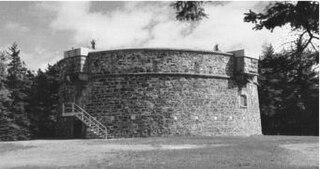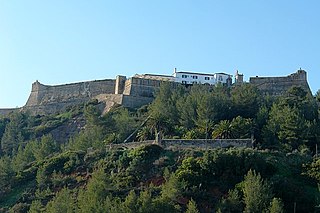Related Research Articles
Year 1565 (MDLXV) was a common year starting on Monday of the Julian calendar.

Conrad Gessner was a Swiss physician, naturalist, bibliographer, and philologist. Born into a poor family in Zürich, Switzerland, his father and teachers quickly realised his talents and supported him through university, where he studied classical languages, theology and medicine. He became Zürich's city physician, but was able to spend much of his time on collecting, research and writing. Gessner compiled monumental works on bibliography and zoology and was working on a major botanical text at the time of his death from plague at the age of 49. He is regarded as the father of modern scientific bibliography, zoology and botany. He was frequently the first to describe species of plants or animals in Europe, such as the tulip in 1559. A number of plants and animals have been named after him.

Martello towers, sometimes known simply as Martellos, are small defensive forts that were built across the British Empire during the 19th century, from the time of the French Revolutionary Wars onwards. Most were coastal forts.

Rogliano is a commune in the French department of Haute-Corse, Corsica.
Historia animalium, published in Zurich in 1551–1558 and 1587, is an encyclopedic "inventory of renaissance zoology" by Conrad Gessner (1516–1565). Gessner was a medical doctor and professor at the Carolinum in Zürich, the precursor of the University of Zurich. The Historia animalium, after Aristotle's work of the same name, is the first modern zoological work that attempts to describe all the animals known, and the first bibliography of natural history writings. The five volumes of natural history of animals cover more than 4500 pages.

The Tower of Mortella is a ruined Genoese tower on Corsica, located on the coast near Punta Mortella in the commune of Saint-Florent, Haute-Corse. It was a progenitor of the numerous Martello towers the British built in the 19th century throughout their empire.

The Genoese towers in Corsica are a series of coastal defences constructed by the Republic of Genoa between 1530 and 1620 to stem the attacks by Barbary pirates.

The siege of San Fiorenzo was a British military operation, supported by Corsican partisans early in the French Revolutionary Wars against the French-held town of San Fiorenzo on the Mediterranean island of Corsica. The Corsican people had risen up against the French Republican garrison in 1793 after an attempt to arrest the Corsican leader Pasquale Paoli during the Reign of Terror. The French had then been driven into three fortified towns on the northern coast; San Fiorenzo, Calvi, and Bastia and Paoli appealed to the British Royal Navy's Mediterranean Fleet, commanded by Lord Hood, for assistance against the French garrison.
The year 1554 CE in science and technology included a number of events, some of which are listed here.

The Charles V Wall is a 16th-century defensive curtain wall that forms part of the fortifications of the British Overseas Territory of Gibraltar. Originally called Muralla de San Benito, it was built in 1540 and strengthened in 1552 by Holy Roman Emperor Charles V. The wall remains largely intact and extends from South Bastion, which was once at the water's edge in the harbour, to the top ridge of the Rock of Gibraltar.
Giovan Giacomo Paleari Fratino (1520–1586), known as El Fratin or Il Fratino, was a military engineer who served the Holy Roman Emperor and King of Spain Emperor Charles V, and then his son Philip II of Spain. He is known for having designed the first Martello tower as well as many other fortifications.

The Moorish Wall, also known as the Philip II Wall and formerly the Muralla de San Reymondo is a defensive curtain wall built in the 16th century that formed part of the southern fortifications of the British Overseas Territory of Gibraltar. It was completed by 1575. The wall ran from the top of a steep cliff above the lower section of the Charles V Wall up the slope of the Rock of Gibraltar to its crest, north of the upper section of the Charles V Wall and is now within the Upper Rock Nature Reserve.
Tiburzio Spannocchi (1541–1609) was "king's engineer" to Philip II of Spain and subsequently to Philip III of Spain. He was named "Chief Engineer" in 1601.

The North Bastion, formerly the Baluarte San Pablo was part of the fortifications of Gibraltar, in the north of the peninsula, protecting the town against attack from the mainland of Spain. The bastion was based on the older Giralda tower, built in 1309. The bastion, with a mole that extended into the Bay of Gibraltar to the west and a curtain wall stretching to the Rock of Gibraltar on its east, was a key element in the defenses of the peninsula. After the British took Gibraltar in 1704 they further strengthened these fortifications, flooding the land in front and turning the curtain wall into the Grand Battery.

Francesco Laparelli da Cortona was an Italian architect. He was an assistant of Michelangelo, and later was sent by the Pope to supervise the construction of Valletta in Malta.

Jumper's Bastion may refer to one of two adjacent bastions in the British Overseas Territory of Gibraltar. They were both created in 1785 on the sites of previous constructions and named for a British Captain who was one on the first on shore during the Capture of Gibraltar in 1704.
The Martello Tower in Hambantota, is a small circular shaped fort, inspired by the Martello tower.

The Fort of São Filipe de Setúbal, also referred to as the São Filipe Castle or the São Filipe Fortress, is in the city of Setúbal in the Setúbal District, of Portugal. The fort was built on the orders of Philip II of Spain, who personally witnessed the laying of the cornerstone of the new fortification in 1582. It stands in a dominant position on the right bank of the mouth of the Sado River, overlooking the centre of Setúbal to its east and guarding access to the river. Named after the king during the Iberian Union, the fortress was designed by Giovan Giacomo Paleari Fratino and had the Italian military engineer Filipe Terzi, who worked for the Spanish Royal Court, as its chief engineer. It was completed in 1600 under the guidance of Leonardo Torreano due to the death of Terzi.

Giacomo Lomellini was the 97th Doge of the Republic of Genoa.
References
- ↑ Grun, Bernard (1991). The Timetables of History (3rd ed.). New York: Simon & Schuster. p. 249.
- ↑ Palmer, Alan; Palmer, Veronica (1992). The Chronology of British History. London: Century Ltd. pp. 153–156. ISBN 0-7126-5616-2.
- ↑ Vigano, Marino (2001). "Giovan Giacomo Paleari Fratino and the Tower at Mortella Point, Corsica (1563)". Fort. Fortress Study Group. 29: 41–57.